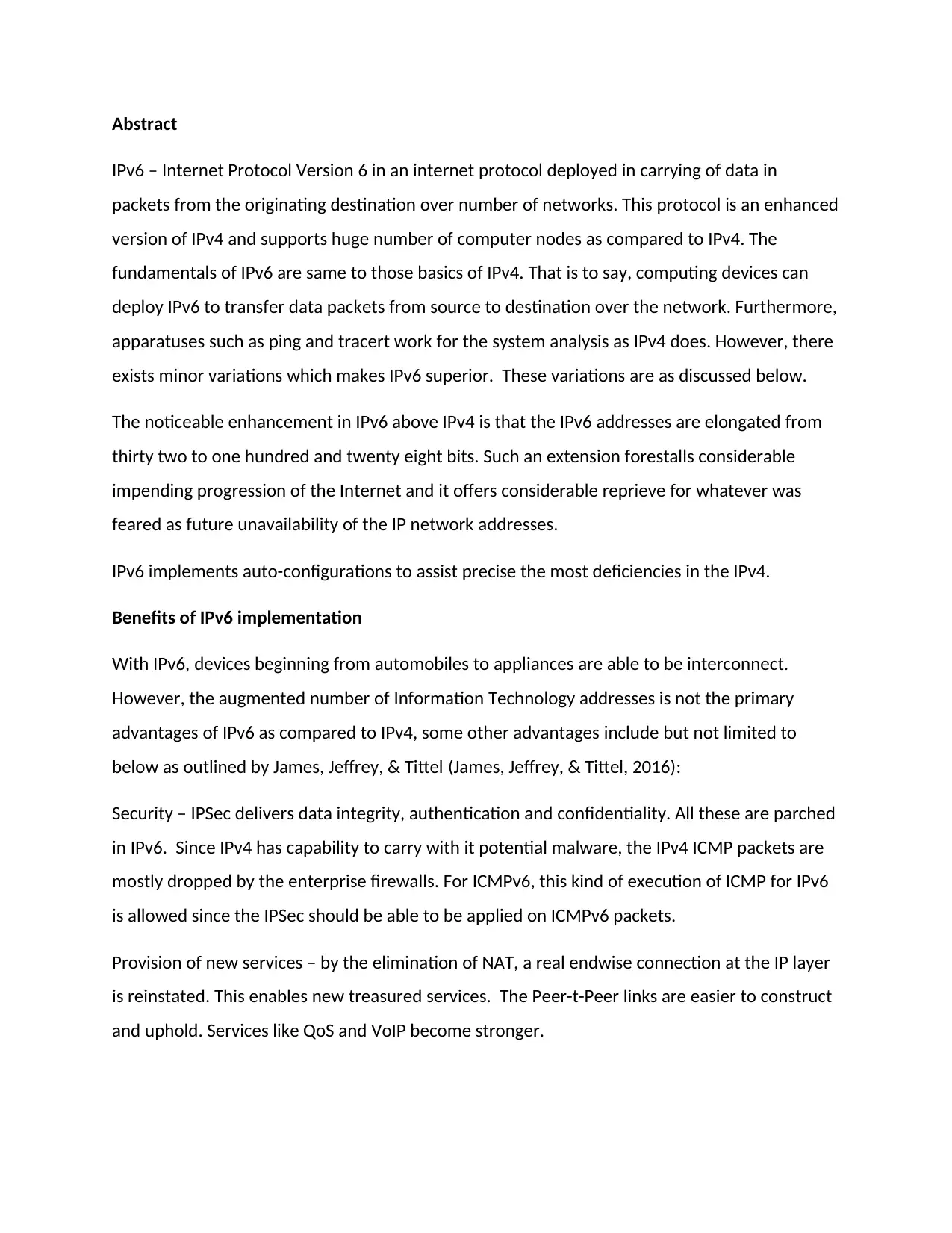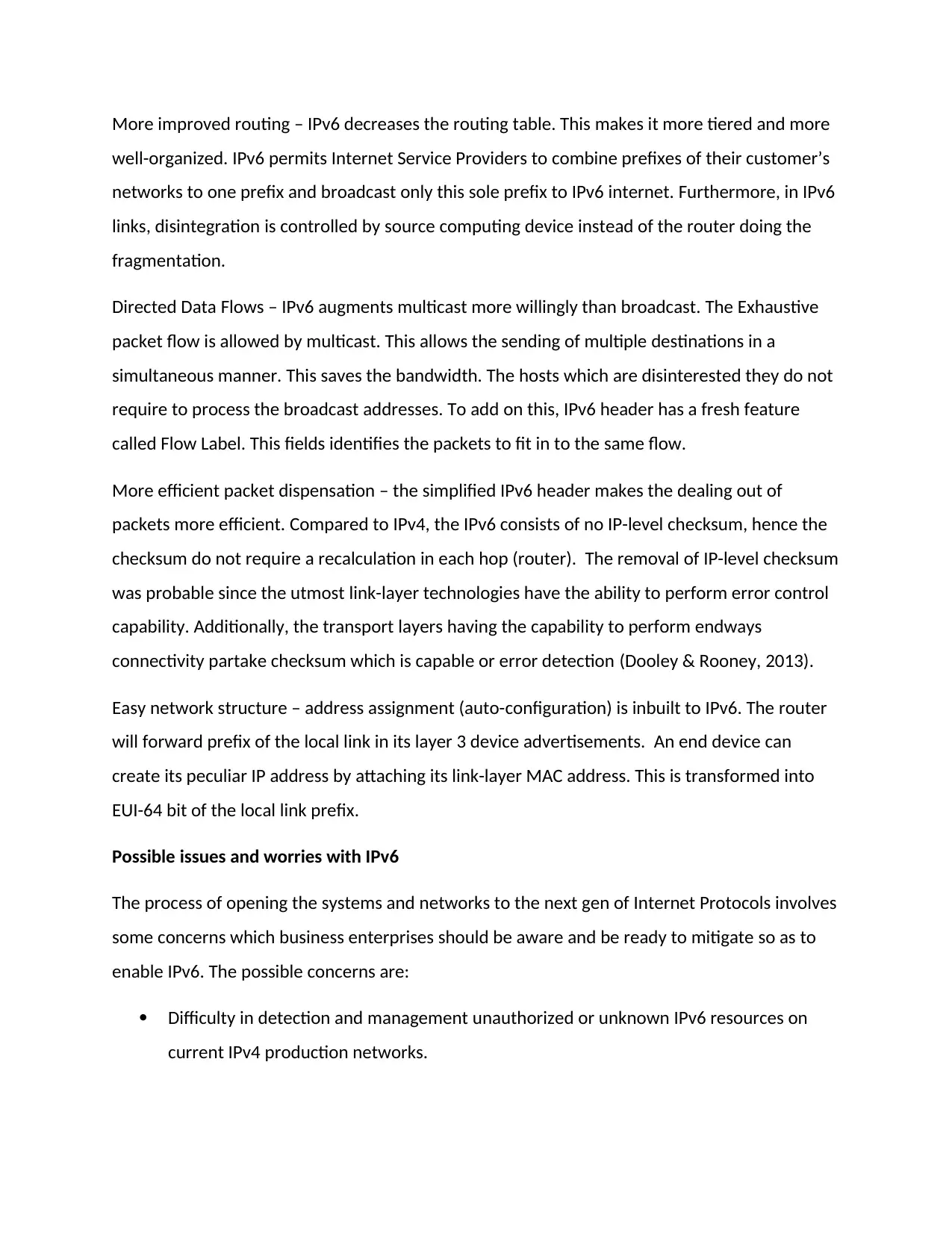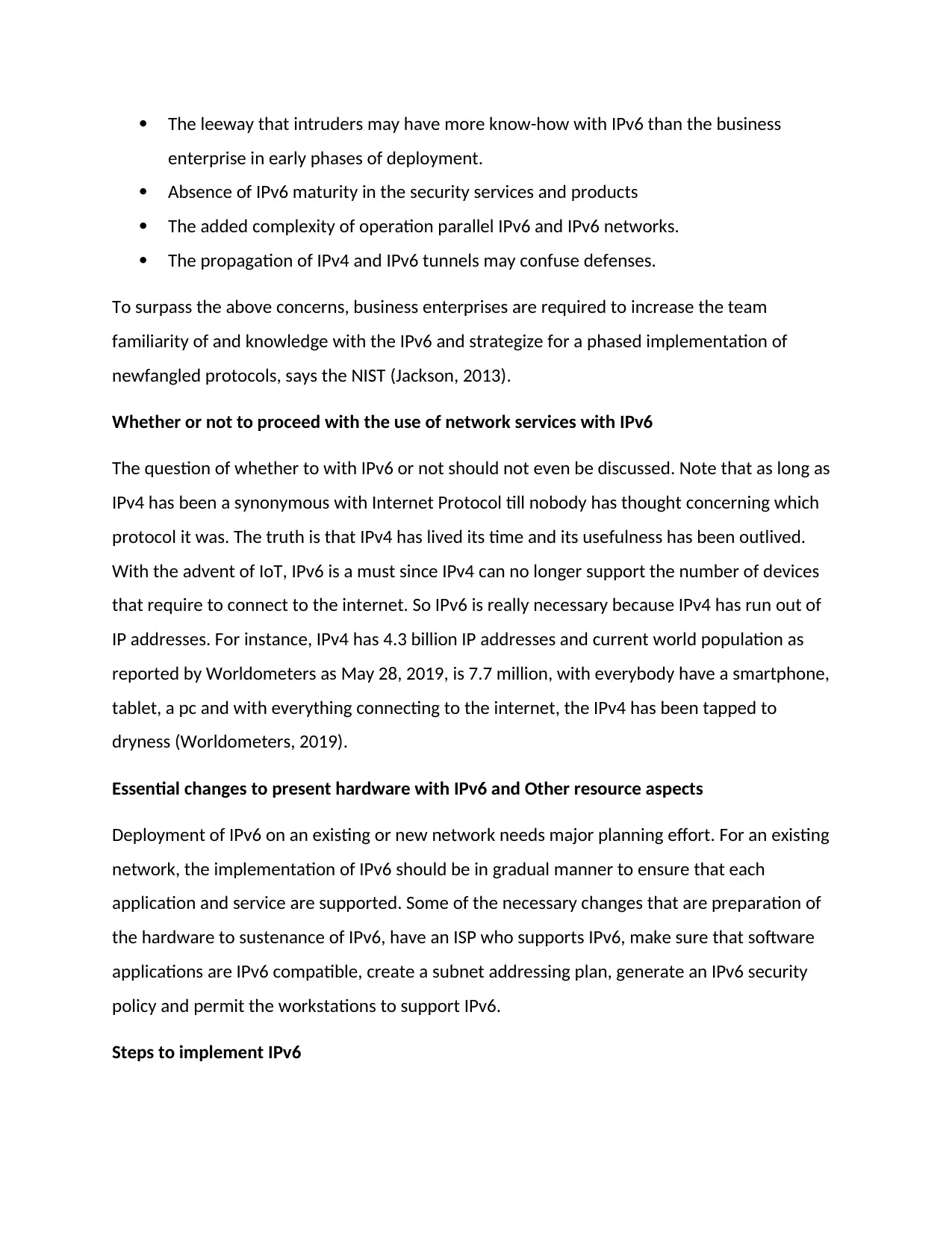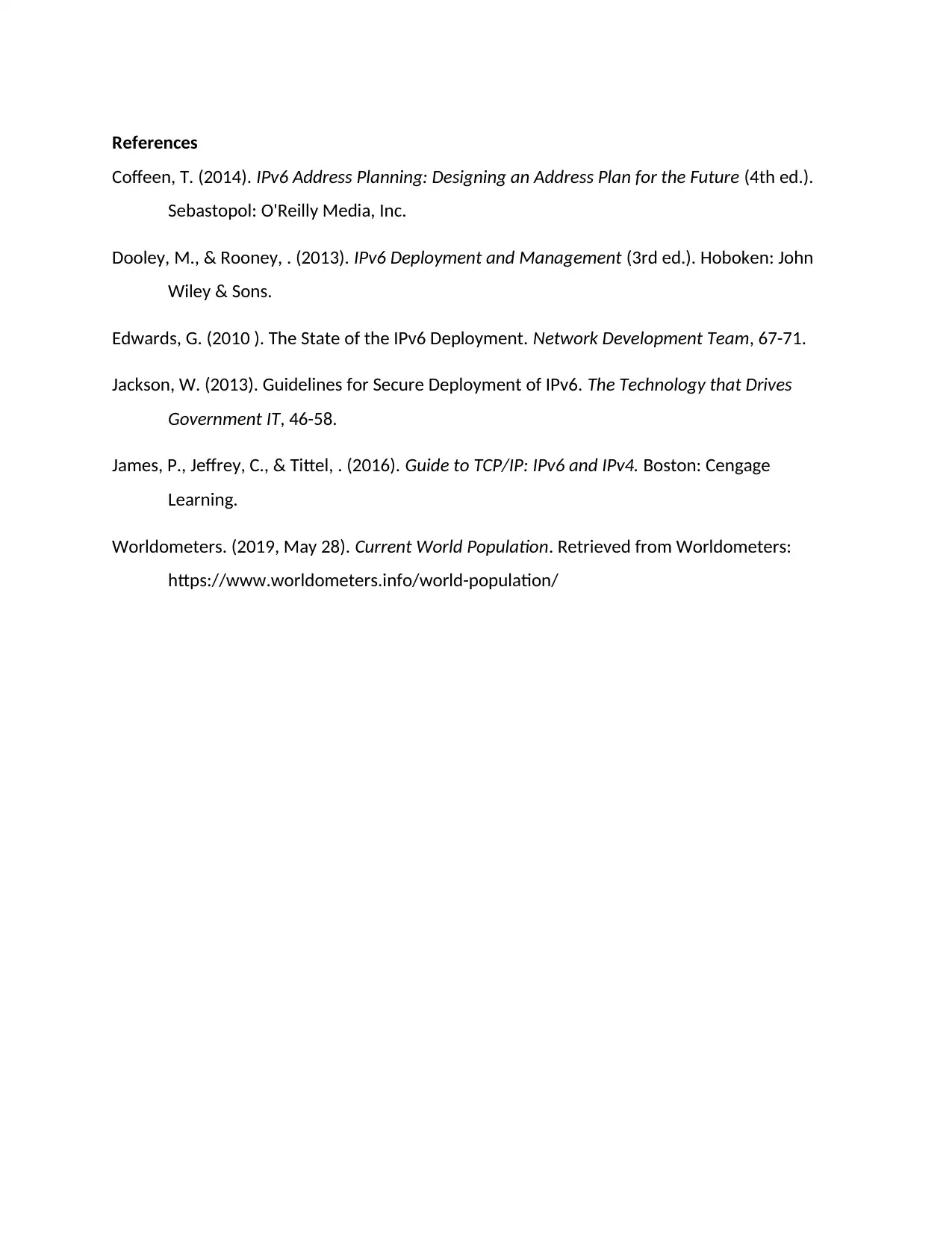Analysis and Design of IPv6 Network Infrastructure for Z Corporation
VerifiedAdded on 2022/11/18
|6
|1327
|112
Report
AI Summary
This report provides an in-depth analysis of IPv6, the next-generation Internet Protocol. It begins with an overview of IPv6, highlighting its enhancements over IPv4, including extended address space and auto-configuration capabilities. The report then explores the benefits of IPv6 implementation, such as enhanced security through IPSec, improved routing efficiency, and support for new services like QoS and VoIP. It also addresses potential issues and concerns associated with IPv6 deployment, such as the need for increased team knowledge and the complexity of operating parallel IPv4 and IPv6 networks. The report emphasizes the necessity of adopting IPv6 due to the limitations of IPv4 and the increasing demands of the Internet of Things (IoT). Furthermore, it outlines essential changes to existing hardware and provides steps for implementing IPv6, including network device audits, service audits, and the creation of a formal implementation plan and IP addressing policy. The report concludes by referencing key sources and providing valuable insights for network infrastructure design and implementation within the context of Z Corporation.

Assignment title and code:
Student name:
Assessor name:
Student Affiliation:
Submission date:
Student name:
Assessor name:
Student Affiliation:
Submission date:
Paraphrase This Document
Need a fresh take? Get an instant paraphrase of this document with our AI Paraphraser

Abstract
IPv6 – Internet Protocol Version 6 in an internet protocol deployed in carrying of data in
packets from the originating destination over number of networks. This protocol is an enhanced
version of IPv4 and supports huge number of computer nodes as compared to IPv4. The
fundamentals of IPv6 are same to those basics of IPv4. That is to say, computing devices can
deploy IPv6 to transfer data packets from source to destination over the network. Furthermore,
apparatuses such as ping and tracert work for the system analysis as IPv4 does. However, there
exists minor variations which makes IPv6 superior. These variations are as discussed below.
The noticeable enhancement in IPv6 above IPv4 is that the IPv6 addresses are elongated from
thirty two to one hundred and twenty eight bits. Such an extension forestalls considerable
impending progression of the Internet and it offers considerable reprieve for whatever was
feared as future unavailability of the IP network addresses.
IPv6 implements auto-configurations to assist precise the most deficiencies in the IPv4.
Benefits of IPv6 implementation
With IPv6, devices beginning from automobiles to appliances are able to be interconnect.
However, the augmented number of Information Technology addresses is not the primary
advantages of IPv6 as compared to IPv4, some other advantages include but not limited to
below as outlined by James, Jeffrey, & Tittel (James, Jeffrey, & Tittel, 2016):
Security – IPSec delivers data integrity, authentication and confidentiality. All these are parched
in IPv6. Since IPv4 has capability to carry with it potential malware, the IPv4 ICMP packets are
mostly dropped by the enterprise firewalls. For ICMPv6, this kind of execution of ICMP for IPv6
is allowed since the IPSec should be able to be applied on ICMPv6 packets.
Provision of new services – by the elimination of NAT, a real endwise connection at the IP layer
is reinstated. This enables new treasured services. The Peer-t-Peer links are easier to construct
and uphold. Services like QoS and VoIP become stronger.
IPv6 – Internet Protocol Version 6 in an internet protocol deployed in carrying of data in
packets from the originating destination over number of networks. This protocol is an enhanced
version of IPv4 and supports huge number of computer nodes as compared to IPv4. The
fundamentals of IPv6 are same to those basics of IPv4. That is to say, computing devices can
deploy IPv6 to transfer data packets from source to destination over the network. Furthermore,
apparatuses such as ping and tracert work for the system analysis as IPv4 does. However, there
exists minor variations which makes IPv6 superior. These variations are as discussed below.
The noticeable enhancement in IPv6 above IPv4 is that the IPv6 addresses are elongated from
thirty two to one hundred and twenty eight bits. Such an extension forestalls considerable
impending progression of the Internet and it offers considerable reprieve for whatever was
feared as future unavailability of the IP network addresses.
IPv6 implements auto-configurations to assist precise the most deficiencies in the IPv4.
Benefits of IPv6 implementation
With IPv6, devices beginning from automobiles to appliances are able to be interconnect.
However, the augmented number of Information Technology addresses is not the primary
advantages of IPv6 as compared to IPv4, some other advantages include but not limited to
below as outlined by James, Jeffrey, & Tittel (James, Jeffrey, & Tittel, 2016):
Security – IPSec delivers data integrity, authentication and confidentiality. All these are parched
in IPv6. Since IPv4 has capability to carry with it potential malware, the IPv4 ICMP packets are
mostly dropped by the enterprise firewalls. For ICMPv6, this kind of execution of ICMP for IPv6
is allowed since the IPSec should be able to be applied on ICMPv6 packets.
Provision of new services – by the elimination of NAT, a real endwise connection at the IP layer
is reinstated. This enables new treasured services. The Peer-t-Peer links are easier to construct
and uphold. Services like QoS and VoIP become stronger.

More improved routing – IPv6 decreases the routing table. This makes it more tiered and more
well-organized. IPv6 permits Internet Service Providers to combine prefixes of their customer’s
networks to one prefix and broadcast only this sole prefix to IPv6 internet. Furthermore, in IPv6
links, disintegration is controlled by source computing device instead of the router doing the
fragmentation.
Directed Data Flows – IPv6 augments multicast more willingly than broadcast. The Exhaustive
packet flow is allowed by multicast. This allows the sending of multiple destinations in a
simultaneous manner. This saves the bandwidth. The hosts which are disinterested they do not
require to process the broadcast addresses. To add on this, IPv6 header has a fresh feature
called Flow Label. This fields identifies the packets to fit in to the same flow.
More efficient packet dispensation – the simplified IPv6 header makes the dealing out of
packets more efficient. Compared to IPv4, the IPv6 consists of no IP-level checksum, hence the
checksum do not require a recalculation in each hop (router). The removal of IP-level checksum
was probable since the utmost link-layer technologies have the ability to perform error control
capability. Additionally, the transport layers having the capability to perform endways
connectivity partake checksum which is capable or error detection (Dooley & Rooney, 2013).
Easy network structure – address assignment (auto-configuration) is inbuilt to IPv6. The router
will forward prefix of the local link in its layer 3 device advertisements. An end device can
create its peculiar IP address by attaching its link-layer MAC address. This is transformed into
EUI-64 bit of the local link prefix.
Possible issues and worries with IPv6
The process of opening the systems and networks to the next gen of Internet Protocols involves
some concerns which business enterprises should be aware and be ready to mitigate so as to
enable IPv6. The possible concerns are:
Difficulty in detection and management unauthorized or unknown IPv6 resources on
current IPv4 production networks.
well-organized. IPv6 permits Internet Service Providers to combine prefixes of their customer’s
networks to one prefix and broadcast only this sole prefix to IPv6 internet. Furthermore, in IPv6
links, disintegration is controlled by source computing device instead of the router doing the
fragmentation.
Directed Data Flows – IPv6 augments multicast more willingly than broadcast. The Exhaustive
packet flow is allowed by multicast. This allows the sending of multiple destinations in a
simultaneous manner. This saves the bandwidth. The hosts which are disinterested they do not
require to process the broadcast addresses. To add on this, IPv6 header has a fresh feature
called Flow Label. This fields identifies the packets to fit in to the same flow.
More efficient packet dispensation – the simplified IPv6 header makes the dealing out of
packets more efficient. Compared to IPv4, the IPv6 consists of no IP-level checksum, hence the
checksum do not require a recalculation in each hop (router). The removal of IP-level checksum
was probable since the utmost link-layer technologies have the ability to perform error control
capability. Additionally, the transport layers having the capability to perform endways
connectivity partake checksum which is capable or error detection (Dooley & Rooney, 2013).
Easy network structure – address assignment (auto-configuration) is inbuilt to IPv6. The router
will forward prefix of the local link in its layer 3 device advertisements. An end device can
create its peculiar IP address by attaching its link-layer MAC address. This is transformed into
EUI-64 bit of the local link prefix.
Possible issues and worries with IPv6
The process of opening the systems and networks to the next gen of Internet Protocols involves
some concerns which business enterprises should be aware and be ready to mitigate so as to
enable IPv6. The possible concerns are:
Difficulty in detection and management unauthorized or unknown IPv6 resources on
current IPv4 production networks.
⊘ This is a preview!⊘
Do you want full access?
Subscribe today to unlock all pages.

Trusted by 1+ million students worldwide

The leeway that intruders may have more know-how with IPv6 than the business
enterprise in early phases of deployment.
Absence of IPv6 maturity in the security services and products
The added complexity of operation parallel IPv6 and IPv6 networks.
The propagation of IPv4 and IPv6 tunnels may confuse defenses.
To surpass the above concerns, business enterprises are required to increase the team
familiarity of and knowledge with the IPv6 and strategize for a phased implementation of
newfangled protocols, says the NIST (Jackson, 2013).
Whether or not to proceed with the use of network services with IPv6
The question of whether to with IPv6 or not should not even be discussed. Note that as long as
IPv4 has been a synonymous with Internet Protocol till nobody has thought concerning which
protocol it was. The truth is that IPv4 has lived its time and its usefulness has been outlived.
With the advent of IoT, IPv6 is a must since IPv4 can no longer support the number of devices
that require to connect to the internet. So IPv6 is really necessary because IPv4 has run out of
IP addresses. For instance, IPv4 has 4.3 billion IP addresses and current world population as
reported by Worldometers as May 28, 2019, is 7.7 million, with everybody have a smartphone,
tablet, a pc and with everything connecting to the internet, the IPv4 has been tapped to
dryness (Worldometers, 2019).
Essential changes to present hardware with IPv6 and Other resource aspects
Deployment of IPv6 on an existing or new network needs major planning effort. For an existing
network, the implementation of IPv6 should be in gradual manner to ensure that each
application and service are supported. Some of the necessary changes that are preparation of
the hardware to sustenance of IPv6, have an ISP who supports IPv6, make sure that software
applications are IPv6 compatible, create a subnet addressing plan, generate an IPv6 security
policy and permit the workstations to support IPv6.
Steps to implement IPv6
enterprise in early phases of deployment.
Absence of IPv6 maturity in the security services and products
The added complexity of operation parallel IPv6 and IPv6 networks.
The propagation of IPv4 and IPv6 tunnels may confuse defenses.
To surpass the above concerns, business enterprises are required to increase the team
familiarity of and knowledge with the IPv6 and strategize for a phased implementation of
newfangled protocols, says the NIST (Jackson, 2013).
Whether or not to proceed with the use of network services with IPv6
The question of whether to with IPv6 or not should not even be discussed. Note that as long as
IPv4 has been a synonymous with Internet Protocol till nobody has thought concerning which
protocol it was. The truth is that IPv4 has lived its time and its usefulness has been outlived.
With the advent of IoT, IPv6 is a must since IPv4 can no longer support the number of devices
that require to connect to the internet. So IPv6 is really necessary because IPv4 has run out of
IP addresses. For instance, IPv4 has 4.3 billion IP addresses and current world population as
reported by Worldometers as May 28, 2019, is 7.7 million, with everybody have a smartphone,
tablet, a pc and with everything connecting to the internet, the IPv4 has been tapped to
dryness (Worldometers, 2019).
Essential changes to present hardware with IPv6 and Other resource aspects
Deployment of IPv6 on an existing or new network needs major planning effort. For an existing
network, the implementation of IPv6 should be in gradual manner to ensure that each
application and service are supported. Some of the necessary changes that are preparation of
the hardware to sustenance of IPv6, have an ISP who supports IPv6, make sure that software
applications are IPv6 compatible, create a subnet addressing plan, generate an IPv6 security
policy and permit the workstations to support IPv6.
Steps to implement IPv6
Paraphrase This Document
Need a fresh take? Get an instant paraphrase of this document with our AI Paraphraser

As discussed before, the time is now to implement IPv6. Below are steps plan to implement
IPv6 deployment as discussed by Edwards, (Edwards, 2010 ).
i. Execute a network device audit.
ii. Execute audit of the services
iii. Come up with a formal implementation plan and
iv. Come up with a formal IP addressing policy as proposed by Coffeen, (Coffeen, 2014).
IPv6 deployment as discussed by Edwards, (Edwards, 2010 ).
i. Execute a network device audit.
ii. Execute audit of the services
iii. Come up with a formal implementation plan and
iv. Come up with a formal IP addressing policy as proposed by Coffeen, (Coffeen, 2014).

References
Coffeen, T. (2014). IPv6 Address Planning: Designing an Address Plan for the Future (4th ed.).
Sebastopol: O'Reilly Media, Inc.
Dooley, M., & Rooney, . (2013). IPv6 Deployment and Management (3rd ed.). Hoboken: John
Wiley & Sons.
Edwards, G. (2010 ). The State of the IPv6 Deployment. Network Development Team, 67-71.
Jackson, W. (2013). Guidelines for Secure Deployment of IPv6. The Technology that Drives
Government IT, 46-58.
James, P., Jeffrey, C., & Tittel, . (2016). Guide to TCP/IP: IPv6 and IPv4. Boston: Cengage
Learning.
Worldometers. (2019, May 28). Current World Population. Retrieved from Worldometers:
https://www.worldometers.info/world-population/
Coffeen, T. (2014). IPv6 Address Planning: Designing an Address Plan for the Future (4th ed.).
Sebastopol: O'Reilly Media, Inc.
Dooley, M., & Rooney, . (2013). IPv6 Deployment and Management (3rd ed.). Hoboken: John
Wiley & Sons.
Edwards, G. (2010 ). The State of the IPv6 Deployment. Network Development Team, 67-71.
Jackson, W. (2013). Guidelines for Secure Deployment of IPv6. The Technology that Drives
Government IT, 46-58.
James, P., Jeffrey, C., & Tittel, . (2016). Guide to TCP/IP: IPv6 and IPv4. Boston: Cengage
Learning.
Worldometers. (2019, May 28). Current World Population. Retrieved from Worldometers:
https://www.worldometers.info/world-population/
⊘ This is a preview!⊘
Do you want full access?
Subscribe today to unlock all pages.

Trusted by 1+ million students worldwide
1 out of 6
Related Documents
Your All-in-One AI-Powered Toolkit for Academic Success.
+13062052269
info@desklib.com
Available 24*7 on WhatsApp / Email
![[object Object]](/_next/static/media/star-bottom.7253800d.svg)
Unlock your academic potential
Copyright © 2020–2025 A2Z Services. All Rights Reserved. Developed and managed by ZUCOL.


